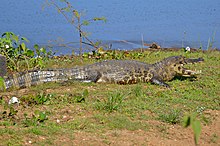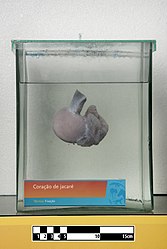Yacare caiman
| Yacare caiman Temporal range: Late Miocene – Present, | |
|---|---|
 | |
| Mato Grosso, Brazil | |
| Scientific classification | |
| Domain: | Eukaryota |
| Kingdom: | Animalia |
| Phylum: | Chordata |
| Class: | Reptilia |
| Clade: | Archosauromorpha |
| Clade: | Archosauriformes |
| Order: | Crocodilia |
| Family: | Alligatoridae |
| Subfamily: | Caimaninae |
| Clade: | Jacarea |
| Genus: | Caiman |
| Species: | C. yacare |
| Binomial name | |
| Caiman yacare Daudin, 1802 | |
 | |
| Range (black) | |
| Synonyms[4] | |
The yacare caiman (Caiman yacare), also known commonly as the jacare caiman, Paraguayan caiman, piranha caiman, red caiman,[5] and southern spectacled caiman,[6] is a species of caiman, a crocodilian in the family Alligatoridae. The species is endemic to Argentina, Bolivia, Brazil, and Paraguay. Brown in color and covered with dark blotches, males grow to a total length (including tail) of 2–3 m (6 ft 7 in – 9 ft 10 in) and weigh around 40–50 kg (88–110 lb); while females grow to 1.4 m (4 ft 7 in) long and about 15–20 kg (33–44 lb).[7] Typical habitats of this caiman include lakes, rivers, and wetlands. Its diet primarily consists of aquatic animals, such as snails, and occasionally land vertebrates. Mating occurs in the rainy season and eggs hatch in March, with young fending for themselves as soon as they hatch. The yacare caiman was hunted heavily for its skin to use for leather in the 1980s, which caused its population to decrease significantly. However, trading restrictions placed since have caused its population to increase. Its population in the Pantanal is about 10 million, and it is listed as least concern on the IUCN Red List.
Taxonomy[edit]
François Marie Daudin originally described the yacare caiman in 1802 as Crocodilus yacare.[8]: 7 Its specific name, yacare, comes from the word jacaré, which means "alligator" in Old Tupi and then assimilated into Portuguese.[6] As of 2010, the exact relationship between the yacare caiman and related species is unclear and complicated. There have been attempts to analyze this relationship, but these have not produced definite conclusions. It is sometimes considered a subspecies of the spectacled caiman (Caiman crocodilus), which would make its scientific name Caiman crocodilus yacare. These two species are the same morphologically, but are considered separate species due to their geographical differences.[9]: 24
Description[edit]
C. yacare is a medium-sized caiman, brown in color.[5] Male specimens grow to 2–3 m (6 ft 7 in – 9 ft 10 in) in total length (including tail) and up to 58 kg (128 lb) in weight. Females are much smaller, with an adult total length of 1.4 m (4 ft 7 in) and weight of 14–23 kg (31–51 lb).[10][8]: 7 The average snout–vent length (SVL) of hatchlings is 12.49 cm (4.92 in) for females and 12.84 cm (5.06 in) for males.[7] National Geographic has described young individuals as "look(ing) like nothing more than tiny, windblown seeds floating amid the rushes at the edge of a lagoon in Brazil's remote interior."[11] Based on a study of the growth of multiple specimens in the Pantanal from 1987 to 2013, both sexes are about 50 cm (20 in) SVL at age five. By age 15, they have mostly finished growth, with females being about 80 cm (31 in) SVL and males over 100 cm (39 in) SVL. The study also showed that individuals have significant variation in their growth rates.[7]
Dark marks are distributed across the body; most noticeably, its lower jaw is covered with three to five blotches. It has a smooth snout, which is medium in length and broad. It has lumps on its eyelids and a curved ridge between its eyes.[8]: 7 It has osteoderms on its scales, a feature also present in the spectacled caiman. It has an average of 74 teeth, with 5 pre-maxillary, 14–15 maxillary, and 17–21 mandibular.[6] Some of the teeth on its lower jaw can poke through holes in its upper jaw.[8]: 7 This feature makes its teeth more prominent and has been compared to piranhas, which has established the common name "piranha caiman".[5]
- A juvenile, about one month old, in the Pantanal, Brazil
- An up-close view of the head and frontal body, with its dark blotches visible
- Taxidermied specimen
- Heart displayed at the Museum of Veterinary Anatomy FMVZ USP
Ecology[edit]
The yacare caiman is ecologically similar to the spectacled caiman.[9]: 23 It lives in semi-aquatic habitats, including lakes, rivers, and wetlands,[6] but is able to adapt to a variety of habitats. Individuals sometimes move to different locations in groups if their habitat is disturbed.[9]: 24 The species' diet consists of aquatic animals, such as snails and fish, and occasionally snakes.[6] It has also been known to eat capybaras.[11] When hunting for snails, this caiman looks within vegetation floating in water and uses its jaws to break the shells of the snails.[5] In July 1986, the stomach of a specimen in Bolivia was observed to be full of mud, along with small parts of eggshells that likely belonged to a caiman. In general, crocodilians can eat the eggshells of their own young subsequent to the young hatching.[12]
Breeding usually occurs in December–February, in the middle of the rainy season.[6] Nests are constructed by the females, built in a mound shape using mud and rotting vegetation.[5] The species can lay as many as 44 eggs, but it most commonly lays 22–35, with the exact number often depending on the habitat type.[9]: 24 It often exhibits multiple paternity, more so than several other crocodilian species.[13] Females usually protect nests during incubation, but do so less when the human hunting pressure is high, ultimately causing a lower hatching success rate.[9]: 24 Eggs hatch in March.[6] Young exhibit precociality, receiving very little help from their parents and having to care for themselves.[5] They hide in grasses in the daytime, as herons and storks can eat young caimans.[11] Females become sexually mature at age 10–15.[7] Similar species of the yacare caiman live to about age 50, which has been used as an estimate for this caiman's lifespan, but its exact lifespan is unknown.[5]
- Storks, such as this wood stork (right), can prey on juveniles (left)
- An adult resting in the sun
- Fish are a major part of the caiman's diet
- Jaguars occasionally prey on caiman
Distribution and conservation[edit]

The range of the yacare caiman includes Argentina (north), Bolivia, Brazil (south), and Paraguay.[10] It is one of three species of genus Caiman in South America, the others being the broad-snouted caiman (C. latirostris) and the spectacled caiman (C. crocodilus), with more easterly and northerly ranges, respectively. The yacare caiman is one of the most common species on its continent.[13]
In the 1980s, the species was "heading for oblivion" due to frequently being hunted for its skin;[11] hunters often went to water holes containing many yacare caimans and shot large numbers of them. They utilized the skin for leather and left the other parts of the carcasses at the water holes.[11] Although the species is covered with bony osteoderms, which had previously made it uncommon to be hunted for leather, it has some less bony spots which can be used for leather.[8]: 582 This practice caused the caiman's population to drop by the millions. In 1992, a ban was issued in Brazil that prohibited the trading of crocodilian skins. This resulted in a significant increase in its population, with about 10 million specimens living in the Pantanal alone as of 2013.[11] Current threats of the yacare caiman include deforestation, tourism, construction of dams and seaports, and illegal hunting.[11] The species reproduces quickly, which makes it less susceptible to hunting pressure.[6]
The IUCN Red List designated the yacare caiman a species of least concern in 1996.[2] It is listed as threatened by the United States Fish and Wildlife Service as of June 5, 2000, after having been listed as endangered since June 2, 1970.[14] As of 2010, it is listed as an Appendix II species by the Convention on International Trade in Endangered Species of Wild Fauna and Flora.[9]: 23
References[edit]
- ^ Rio, Jonathan P.; Mannion, Philip D. (6 September 2021). "Phylogenetic analysis of a new morphological dataset elucidates the evolutionary history of Crocodylia and resolves the long-standing gharial problem". PeerJ. 9: e12094. doi:10.7717/peerj.12094. PMC 8428266. PMID 34567843.
- ^ a b Campos, Z.; Llobet, A.; Magnusson, W.E.; Piña, C. (2020). "Caiman yacare". IUCN Red List of Threatened Species. 2020: e.T46586A3009881. doi:10.2305/IUCN.UK.2020-3.RLTS.T46586A3009881.en. Retrieved 19 November 2021.
- ^ "Appendices | CITES". cites.org. Retrieved 2022-01-14.
- ^ Species Caiman yacare at The Reptile Database
- ^ a b c d e f g "Yacare Caiman". Beardsley Zoo. Retrieved 28 February 2019.
- ^ a b c d e f g h Britton, Adam. "Yacare caiman (Caiman yacare)". Crocodilians: Natural History and Conservation. Retrieved 27 February 2019.
- ^ a b c d Campos, Zilca; Mourão, Guilherme; Coutinho, Marcos; Magnusson, William E. (February 28, 2014). "Growth of Caiman crocodilus yacare in the Brazilian Pantanal". PLOS One. 9 (2): e89363. doi:10.1371/journal.pone.0089363. PMC 3938444. PMID 24586719.
- ^ a b c d e Grigg, Gordon (January 15, 2015). Biology and Evolution of Crocodylians. CSIRO Publishing. ISBN 978-1486300679. Retrieved 27 February 2019.
- ^ a b c d e f Campos, Z.; Llobet, A.; Piña, C. I.; Magnusson, W. E.; Manolis, C. S.; Stevenson, C. (2010). Crocodiles: Status Survey and Conservation Action Plan (PDF) (third ed.). Crocodile Specialist Group. pp. 23–28. Retrieved 27 February 2019.
- ^ a b "3.3 Caimans". Food and Agriculture Organization of the United Nations.
- ^ a b c d e f g Smith, Roff (July 2013). "Brazil's Yacare Caiman — The Comeback Croc". National Geographic. Archived from the original on February 28, 2019. Retrieved 27 February 2019.
- ^ King, F. Wayne; Godshalk, Robert (2003). "Mud, Root Balls, and Other Tasty Tidbits in Crocodilian Stomach". Florida Museum of Natural History. Retrieved 2 March 2019.
- ^ a b Ojeda, Guillermo N.; Amavet, Patricia C.; Rueda, Eva C.; Siroski, Pablo A.; Larriera, Alejandro (March 1, 2017). "Mating System of Caiman yacare (Reptilia: Alligatoridae) Described from Microsatellite Genotypes". Journal of Heredity. 108 (2): 135–141. doi:10.1093/jhered/esw080. PMID 28175334.
- ^ Fish and Wildlife Service (May 4, 2000). "Endangered and Threatened Wildlife and Plants; Reclassification of Yacare Caiman in South America From Endangered to Threatened, and the Listing of Two Other Caiman Species as Threatened by Reason of Similarity of Appearance". Federal Register: 25867–25881. Retrieved 27 February 2019.
Further reading[edit]
- Daudin FM (1802). Histoire Naturelle, Générale et Particulière des Reptiles; Ouvrage faisant suite à l'Histoire Naturelle générale et particulière, composée par Leclerc de Buffon; et rédigée par C.S. Sonnini, membre de plusieurs sociétés savantes. Tome second. Paris: F. Dufart. 432 pp. (Crocodilus yacare, new species, p. 407). (in French and Latin).
External links[edit]
- Reichert, Michelle N., et al. (2018). "The respiratory mechanics of the yacare caiman (Caiman yacare Daudine) " [sic]. Journal of Experimental Biology 2018: jeb.193037. doi:10.1242/jeb.193037.


 French
French Deutsch
Deutsch







